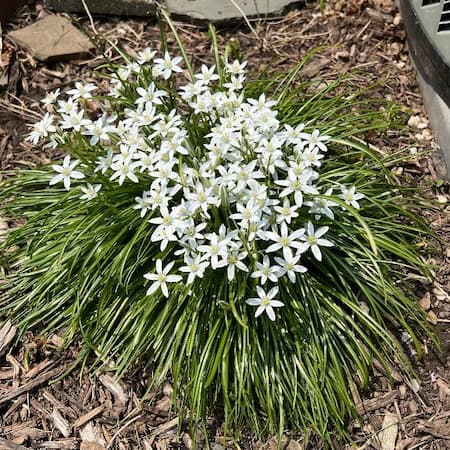How to Grow Star of Bethlehem Flowers

About Growing Star of Bethlehem Flowers in Your Home Garden
While not as well-known as other spring bloomers, Star of Bethlehem flowers shine brightly in mid-spring. It’s a great plant to add to your flower garden. This flowering plant loves a crowd. Grow them in clumps for the best, showy display. The plants are native to the Mediterranean regions. They produce attractive white, star-shaped flowers that are surrounded by lush, grass-like green leaves. Plant Star of Bethlehem bulbs in the fall and this hardy, easy-to-grow perennial will put on a really eye-appealing spring display.
Star of Bethlehem plants look great just about anywhere you want to place them. Try planting them in mixed flower gardens or rock gardens. They give the garden bright, early-season blooms. Partner them in the garden with annuals. As a result, you will have flowers in bloom all season long. As they die back, annuals take over the chore of providing beautiful blooms.
These flowers look great in small planters and containers on your patio or deck. They can be grown indoors too. Also, try potting Star of Bethlehem bulbs in the fall to bloom indoors during the winter. Make sure to plant enough bulbs to fill the planter. Like other bulbs, they require a chilling period. More on Forcing Bulbs. It’s a rewarding winter indoor gardening activity.
Important Note: Star of Bethlehem plants are toxic to humans and pets. Keep them away from small children.
Star of Bethelehem Plant Specifics
Flowers Bloom: In mid-late spring
Flower Colors: White with green stripes
Plant height: 6 to 12 inches tall.
Plant Hardiness Zones: 4 – 9
Ideal Soil pH: 6.0 – 8.0.
Lighting: Sull to partial sun
Toxicity: The plant is toxic to humans and pets.
Other Names: Eleven O’Clock Lady, Grass Lily, Nap at Noon, Summer Snowflake
Perennial, Orinthogalum Umbellatum
Star of Bethlehem Plant Propagation
The Star of Bethlehem flower is grown from bulbs. Plant the small bulbs 3 to 4 inches deep. Plant them in the fall after the weather has cooled. Apply fertilizer or a general-purpose fertilizer at the planting site.
The bulbs need a chilling period as part of their life cycle. In cold regions, these fall-planted bulbs will experience a chilling period naturally over the long winter months. If you are growing them indoors, chill them in the refrigerator or a cold, but not freezing, garage.
This flower can also be propagated from seeds. The seeds are tiny. When planted from seeds, they may take a year or two to produce healthy flowers. Sprinkle them on top of soft, loose soil and lightly water them into the soil. Mark the planting site. The plant is a prolific re-seeder.
Each year, the bulbs will rapidly multiply. When the clumps get too dense, dig them up and separate them into 2 to 4 groups. Then, replant the groups. Your neighbors and gardening friends will love to get a clump or two for their flower garden or deck planters.
Bulb Planting Depth: 3 to 4 inches deep.
How to Grow Star of Bethlehem Flower
Grow Star of Bethlehem flowers in full sun to partial shade. Plant these perennials in a location where they can grow undisturbed for many years. Loamy soil that is loose and well-draining is best. Select a location that is slightly elevated, as the bulbs can rot in wet soils.
Grow these flowers in groups. They look their best in clumps. The plants thrive in rich loam soil. However, they do well in average soil, too. When planting for the first time, mix compost into the planting site. When the plants appear in the spring, apply a thick layer of mulch to keep the weeds down, and for a neat and tidy appearance. As the mulch decomposes, it feeds the plants, too.
These plants are aggressive and can spread to your lawn. We recommend garden edging to help contain them.
For the best results, keep the soil moist but not wet. Water during the growing period only as needed.
As with other plants, we recommend an annual soil test for pH levels and soil fertility. Adujut the soil levels as needed.
In rich soil, the plants do not need fertilizer. For average soil, apply a general-purpose fertilizer early in the growing period.
The flowers bloom once a season. The plants need several hours of sunshine to bloom. Lack of blooms is caused by either inadequate sunshine or too much nitrogen in the soil.
After Blooming Plant Care
Deadheading the spent blooms will not result in a second blooming period. But, it will make the plants look more attractive. Avoid the urge to prune or cut back healthy leaves. It is important to allow the plant to continue to grow until it dies back naturally. Every day the plant’s leaves send energy back to the bub for bigger and better blooms next year.
After the plant has died back for the season, cut the plant back to ground level. In really cold climates, a light layer of mulch helps to protect the bulbs from freezing in the winter. Then as spring arrives, rake the mulch off of the area. This makes it easier for the plants to re-emerge.
Insects, Disease, and Other Plant Problems
The Star of Bethlehem flower plant is resistant to most insect and disease problems. Squirrels and chipmunks leave the small bulbs alone, too.
Bulb rot is the only major concern. It is the result of soggy soil.
Related Articles
Also, people who read this article will like:
Flower Gallery – Find pictures of your favorite flowers.
Flower Bulbs for Sale – And, remember to buy extra for growing indoors in the winter.
Please support our site. Shop for:
- rmmatthews100@hotmail.com
- 585-721-6528
- Rochester, NY
©1999-2024 GardenersNet.Com, All Rights Reserved

